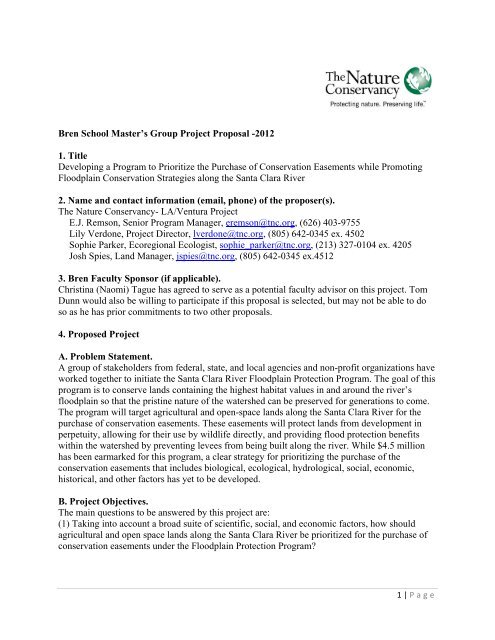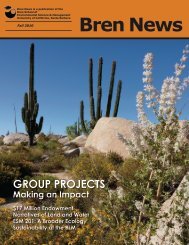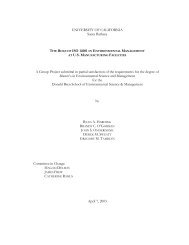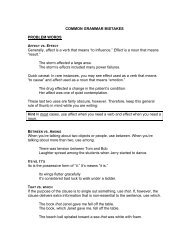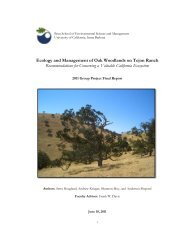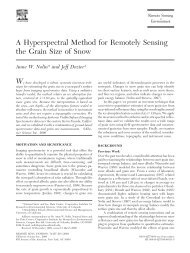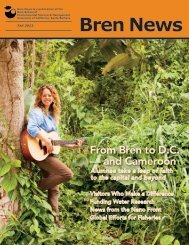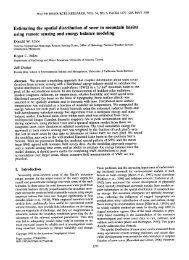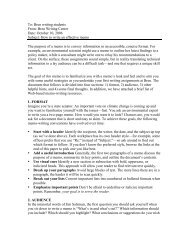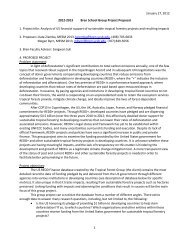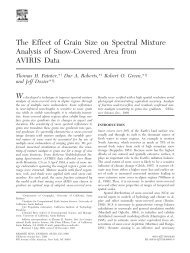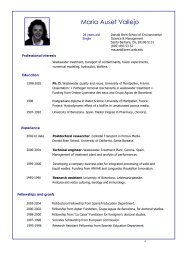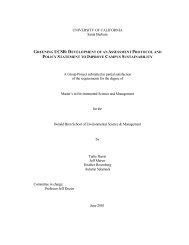Bren School Master's Group Project Proposal -2012 1. Title ...
Bren School Master's Group Project Proposal -2012 1. Title ...
Bren School Master's Group Project Proposal -2012 1. Title ...
You also want an ePaper? Increase the reach of your titles
YUMPU automatically turns print PDFs into web optimized ePapers that Google loves.
<strong>Bren</strong> <strong>School</strong> Master’s <strong>Group</strong> <strong>Project</strong> <strong>Proposal</strong> -<strong>2012</strong><strong>1.</strong> <strong>Title</strong>Developing a Program to Prioritize the Purchase of Conservation Easements while PromotingFloodplain Conservation Strategies along the Santa Clara River2. Name and contact information (email, phone) of the proposer(s).The Nature Conservancy- LA/Ventura <strong>Project</strong>E.J. Remson, Senior Program Manager, eremson@tnc.org, (626) 403-9755Lily Verdone, <strong>Project</strong> Director, lverdone@tnc.org, (805) 642-0345 ex. 4502Sophie Parker, Ecoregional Ecologist, sophie_parker@tnc.org, (213) 327-0104 ex. 4205Josh Spies, Land Manager, jspies@tnc.org, (805) 642-0345 ex.45123. <strong>Bren</strong> Faculty Sponsor (if applicable).Christina (Naomi) Tague has agreed to serve as a potential faculty advisor on this project. TomDunn would also be willing to participate if this proposal is selected, but may not be able to doso as he has prior commitments to two other proposals.4. Proposed <strong>Project</strong>A. Problem Statement.A group of stakeholders from federal, state, and local agencies and non-profit organizations haveworked together to initiate the Santa Clara River Floodplain Protection Program. The goal of thisprogram is to conserve lands containing the highest habitat values in and around the river’sfloodplain so that the pristine nature of the watershed can be preserved for generations to come.The program will target agricultural and open-space lands along the Santa Clara River for thepurchase of conservation easements. These easements will protect lands from development inperpetuity, allowing for their use by wildlife directly, and providing flood protection benefitswithin the watershed by preventing levees from being built along the river. While $4.5 millionhas been earmarked for this program, a clear strategy for prioritizing the purchase of theconservation easements that includes biological, ecological, hydrological, social, economic,historical, and other factors has yet to be developed.B. <strong>Project</strong> Objectives.The main questions to be answered by this project are:(1) Taking into account a broad suite of scientific, social, and economic factors, how shouldagricultural and open space lands along the Santa Clara River be prioritized for the purchase ofconservation easements under the Floodplain Protection Program?1 | Page
(2) Given the history of floodplain conservation easement projects on agricultural lands in theUnited States and current climate change projections, what innovative strategies are appropriatefor the implementation of floodplain protection on the Santa Clara River?C. <strong>Project</strong> Significance.The target audience is The Nature Conservancy. This work is important because it will promoteconservation of a rare natural river system in Southern California. This work will guide TNC’sprioritization of properties for the purchase of conservation easements under the FloodplainProtection Program, allowing for the best use of resources by the program. This will ensure thatthe best lands for conservation are prioritized for protection, and enable the FloodplainProtection Program to operate successfully.D. Background information.The project is located along the Santa Clara River in Ventura County. The Nature Conservancyhas been working to protect ecologically important lands and waters within the Santa Clara RiverWatershed for over ten years. To date, TNC has completed two Conservation Action Plans onthe Santa Clara River. The second of these, entitled “Conservation Plan for the Lower SantaClara River Watershed and Surrounding Areas” was authored by <strong>Bren</strong> <strong>School</strong> interns Iara Lacherand Dakota Corey in 2008. In 2010, <strong>Bren</strong> <strong>School</strong> intern Melissa Gomez compiled a ConceptualArea Protection Plan for the Santa Clara River that allowed TNC to apply for funding from theWildlife Conservation Board for the acquisition of properties for biodiversity conservation alongthe river. All of these plans built on the 2000 <strong>Bren</strong> <strong>School</strong> study entitled “Prioritizing Sites alongthe Santa Clara River for Conservation of Threatened and Endangered Species”.In late 2010, a Hydraulic Impact Analysis was completed for the Santa Clara River FloodplainProtection Program using a hydrological model prepared by the Federal Emergency ManagementAgency (FEMA). It was determined that the Floodplain Protection Program will preserve thefollowing on the Santa Clara River:over 3,000 acres of agriculture and open space lands for flood water storage and floodreduction during a 50-year flood event; over 3,700 acres located within the floodway fringe (areas between floodway and 100-year floodplain boundaries), or over 5,600 acres of lands if the floodway fringe isextended to the 500-year floodplain boundaries, and prevent them from futuredevelopment;nearly 8,000 acres of lands now located within the FEMA defined floodway.In addition, the program is predicted to provide a reduction of $21 million in flood damages tohuman communities during a 50-year event, $204 million during a 100-year event, and $1,048million during a 500-year flood event.The Nature Conservancy currently owns, manages, and is in the process of restoring over 3,000acres along the Santa Clara River. The Floodplain Protection Program is the latest strategy thatTNC will be employing to protect biodiversity within the watershed. By researching the historyand accomplishments of floodplain conservation easement projects more broadly, and bystudying the local scientific and socioeconomic conditions along the Santa Clara River, thisproject will focus on prioritizing lands for the purchase of conservation easements by theFloodplain Protection Program, thereby ensuring the success of the program.2 | Page
E. Stakeholders, other than the client.A large group of stakeholders will benefit from this project, as the Floodplain ProtectionProgram is comprised of a several federal, state, and local agencies and non-profit organizationsin addition to The Nature Conservancy. These include: The Natural Resources ConservationService (NRCS), the Ventura County Farm Bureau, the Ventura County Resource ConservationDistrict, and the Ventura County Watershed Protection District (VCWPD). The results of thisproject will prioritize conservation lands, potentially contributing to listed species recoveryefforts of the U.S. Fish and Wildlife Service (USFWS) and the California Department of Fishand Game (CDFG). Farmers and other private land owners within the floodplain of the SantaClara River stand to benefit economically from this project, which will determine whichagricultural properties should be targeted by the Floodplain Protection Program.F. Possible approaches and available data.Possible approaches: The history of floodplain conservation easement projects can be researched using theinternet and internal TNC documents provided to the <strong>Bren</strong> Student team by TNC staff The prioritization of private properties for inclusion in the Santa Clara River FloodplainProtection Program can be done using various datasets such as TNC’s prioritization ofproperties for conservation acquisition, FEMA maps and model outputs from theHydraulic Impact Analysis, County of Ventura parcel data, Federal Census records, andinformation from the California Department of Fish and Game Natural DiversityDatabase (CNDDB).Available data include: TNC’s prioritization of properties for conservation acquisition from the 2008Conservation Action Plan (maps and other data) Hydraulic Impact Analysis completed for the Santa Clara River Floodplain ProtectionProgram using a hydrological model prepared by FEMA Ventura County Parcel Data Federal Census Data California Department of Fish and Game Natural Diversity Database (CNDDB) Contacts with other state offices and programs within The Nature ConservancyG. Deliverables.In addition to a final written report that details the history/successes/challenges faced by otherfloodplain agricultural easement programs, and the methodology and results related to theprioritization of Santa Clara River floodplain lands, The Nature Conservancy would like to havea map of the Santa Clara River that details the prioritization of privately-owned lands within theSanta Clara River Watershed with regard to the Floodplain Protection Program. The map shouldclearly show which parcels are the highest priority for inclusion in the program, which aremedium priority, and which are of low priority for protection.3 | Page
H. ReferencesThe Nature Conservancy. 2008. Conservation Plan for the Lower Santa Clara River Watershedand Surrounding Areas. Available at: http://conserveonline.org/library/conservation-plan-for-thelower-santa-clara-river/view.html5. ClientThe Nature Conservancy- LA/Ventura <strong>Project</strong>E.J. Remson, Senior Program Manager, eremson@tnc.org, (626) 403-9755Lily Verdone, <strong>Project</strong> Director, lverdone@tnc.org, (805) 642-0345 ex. 4502Sophie Parker, Ecoregional Ecologist, sophie_parker@tnc.org, (213) 327-0104 ex. 4205Josh Spies, Land Manager, jspies@tnc.org, (805) 642-0345 ex.45126. A commitment by the client to provide data and other information required for asuccessful project with no stipulation for a non-disclosure agreement or restriction topublication of the report.All TNC-derived data and publicly-available datasets may be used without restriction, with theexception of TNC maps related to the prioritization of private lands. These maps are sensitivebecause they depict the conservation value and prioritization of privately-held parcels foracquisition by TNC. This information, if made public, could potentially influence the value ofthe lands, preventing TNC from achieving its conservation goals.7. Anticipated financial needs and sources of support:At this time, we do not anticipate that the financial needs of the project will exceed the amountallocated to the project by the <strong>Bren</strong> <strong>School</strong>.a) Anticipated financial needs: (travel, conference fees, etc.)Travel expenses will constitute the bulk of the financial need related to this project. There mayalso be research costs related to accessing public databases.b) Financial sources of support:The Nature Conservancy has funds available to cover additional expenses of the project deemednecessary by TNC.c) Internship stipend amount per student: (paid or unpaid internship? If paid, what is thestipend amount?)see below8. Internship Opportunities. If applicable, how many internship opportunities will beavailable to <strong>Bren</strong> students?TNC is willing to fund two internships during the summer of <strong>2012</strong> related to this project. Theinternships will be paid at a reasonable hourly rate, not to exceed a total of $5,250 for eachstudent.4 | Page


